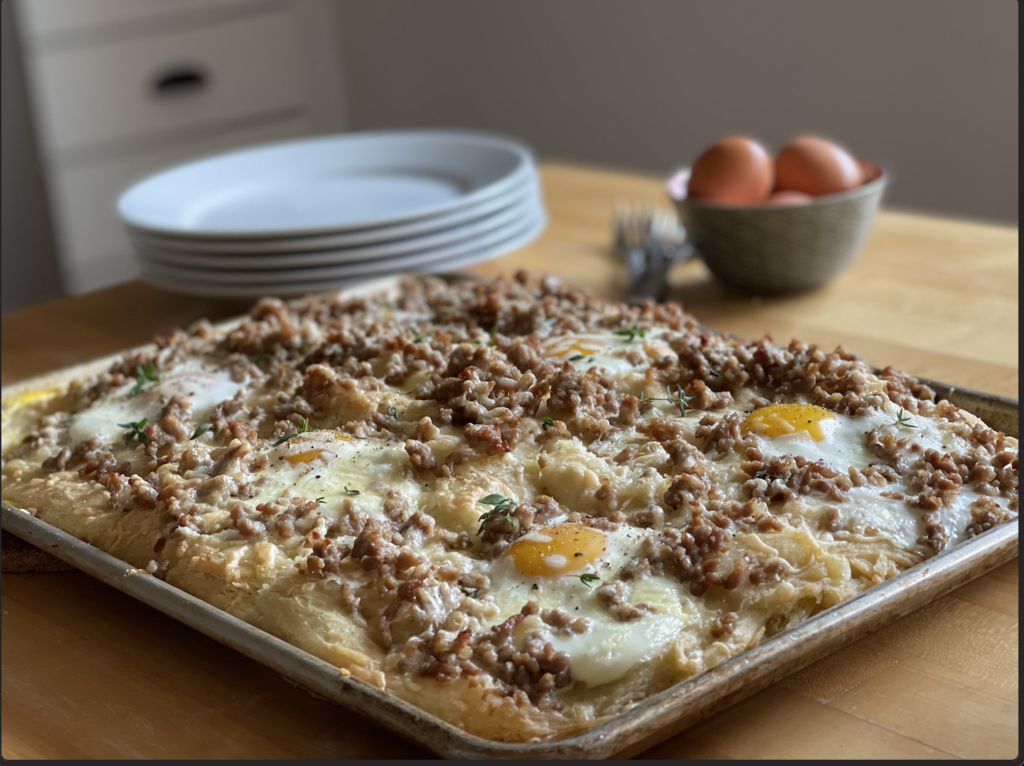The first time I had focaccia, I was visiting Italian relatives in Modena, Italy, when I was 15. A baker handed us a square foot of it across a counter, wrapped in oily brown paper. My second cousin Daria and I ate it for breakfast, washing salty, crispy swallows down with espresso.
Now I live a couple of blocks from Fire Island Rustic Bakeshop in Anchorage. They offer a distinctly un-Italian but still epic breakfast focaccia that involves cooked egg, sourdough, and Irish Cheddar. The pandemic labor shortage led them to reduce their open hours, and they are presently closed on Sunday, which is the day when I most liked to take my little boys there for breakfast. But since necessity is the mother of invention and adversity is the father of reinvention, the bakery’s closure led me to experiment with making focaccia at home.
Mine is no artisanal Fire Island focaccia, but when I sent a few friends pictures of it after I pulled it out of the oven the last time I made it, they found reasons to drop by. So I figure that’s enough.
My favorite focaccia recipe is the no-knead version in Bon Appetit. Over time, I’ve customized it a bit, using King Arthur bread flour when I can find it, and making it thin, oily, and salty, Italian-style, in a sheet pan. To make spots for the eggs, I use balls of foil pressed into the dough for the par bake. You can also just make larger dimples with your fingers, and scoop them out a bit with a spoon, before you crack the egg in. I often use six eggs, but eight work too.
Big Breakfast Focaccia
(serves 6-8)
Ingredients: 2¼ teaspoons (1 packet) active dry yeast
2 teaspoons honey
5 cups bread flour (preferred) or all-purpose flour
1½ tablespoons + ½ teaspoon sea salt
¼ cup plus 3 tablespoons olive oil
¾ pound loose breakfast sausage
6–8 eggs
1½ cups sharp white Cheddar cheese
1½ tablespoons fresh herbs like rosemary, sage, and thyme, finely chopped
Method:
The afternoon before the day you plan to serve your bread, proof your yeast by whisking it and the honey into 2½ cups lukewarm water in a large bowl. Let it sit for a few minutes to make sure the yeast is active. (It should get foamy. If it doesn’t, start over with new yeast.) Add flour and salt and mix with a spatula to make a shaggy dough. Pull the dough from the bowl and on a floured surface with floured hands, briefly, lightly knead, not too much, just until all the flour is mostly combined. Form into a rough ball. Scrape out the bowl and then add ¼ cup of olive oil. Roll the ball lightly in the oil in the bowl and then cover it and refrigerate overnight. You can leave it as little as 4 hours or as long as 24 hours. It should at least double in size.
At least 2½ hours before you plan to eat, pour 2 tablespoons of oil on a rimmed 12×16-inch baking sheet and spread it to the edges with a spatula so it’s well distributed. Make a dough ball with forks. Facing the bowl, use 2 forks to hook and fold the edge farthest from you toward the center of the bowl. Turn the bowl a quarter turn, and repeat 3 more times, deflating the dough while forming a ball. Dump the ball onto the oiled sheet pan, and drizzle the extra oil on top. Use oiled fingers to gently stretch it into a rectangle shape. Allow it to rise for at least 90 minutes in a warm place, until the stretched dough mostly fills the pan.
About 45 minutes before you plan to eat, preheat your oven to 450° F. Make 6–8 golfball-sized balls of aluminum foil. Pour another tablespoon of oil over the dough and use your fingers to press lots of dimples into the dough, at the same time lightly stretching it toward the edges of the pan. Take your foil balls, dip 1 side in oil, and press them oil side down in equidistant spots on the rectangle of dough to make craters to hold your eggs. Sprinkle the focaccia with ½ teaspoon of sea salt. Put the pan in the oven and set your timer for 15 minutes.
While the dough bakes, brown your sausage crumbles. When the timer goes off, pull out the bread, remove the foil balls, and very carefully crack an egg into each crater. (If the crater doesn’t look deep enough, you can hollow it a little more with a spoon.) Sprinkle on sausage and cheese. Return to the oven for 10 more minutes. It should be golden, the cheese should be melted and browned, and the eggs should be done. Sprinkle with herbs before serving.
This recipe originally appeared in Edible Alaska. Subscribe!
